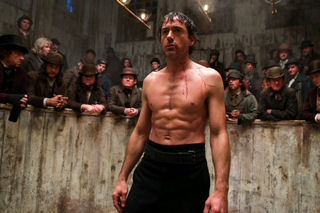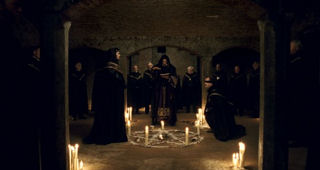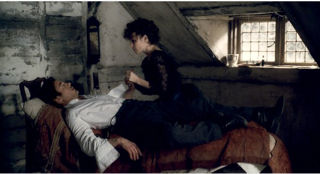|
Sherlock Holmes
I have
adored Sherlock Holmes for as long as I can remember. Well,
since high school when I finally read his adventures by
Sir Arthur Conan Doyle. Holmes has since become one of my
heroes. As a “Sherlockian” (as others would
dub me; I find the title slightly horrifying, personally),
I am generally hesitant to explore other works that involve
the great consulting detective.
But
it is at times such as when I’m faced with a Laurie
R. King novel or a new film adaptation, that I must remind
myself that Doyle himself once told an actor who wished
to change aspects of the first Sherlock Holmes playscript,
“You may marry him, murder him, or do anything you
like to him,” and then I eagerly dive into that novel
or film.
When
I first heard of Guy Ritchie’s take, I was surprised
it was even happening. Until that point, Holmes had been
tucked away mainly on television shows in the 1950s, ‘60s,
and ‘80s, or made for T.V. movies on BBC. It had been
a long time since he had been seen on the silver screen.
I was excited and terrified all at once.
After
several months of fretting, I finally saw the trailer. And
my heart shattered. What I saw in the brief, three-minute
concoction left me with the impression that my hero was
being mocked in the worst way: he appeared to be a comic
book superhero. But still I promised I would give it the
benefit of the doubt and watch it anyway.
I’m
glad I did.
There
are many “Sherlockians” out there in the world
who have already judged the movie as “terrible,”
“horrible,” and “quite possibly the worst
Holmes film to date” without seeing anything more
than the trailer. They have complained against the bare-chested
boxing match against McMurdo, against the explosions, against
everything, really.
What
they refuse to remember from Doyle’s work is that
Holmes was, in fact, a skilled boxer who knew several different
disciplines of unarmed combat. Buildings and items did indeed
explode, especially after Watson, or perhaps Lestrade, unwittingly
tripped the switch. The only thing in the film that wasn’t
in the stories or novels is the somewhat romantic relationship
Holmes had with Irene Adler (Rachel McAdams). But again,
Doyle said, “You may marry him…”
The
biggest complaint I have found while browsing through online
message boards is against the supernatural elements in the
film. Lord Blackwood (Mark Strong) is portrayed as a dealer
in black magic and suchlike. During Queen Victoria’s
reign, there was a substantial rise in the interest in spiritualism,
mysticism, and belief in the occult.
Doyle
was one of many swept up and away by it, and in The
Hound of the Baskervilles, the title character is described
as a gigantic beast of a hound with fire spewing from its
mouth. Of course, even this supernatural aspect was later
revealed to have a scientific and logical explanation.
The
film begins mid-case with Holmes (Robert Downey, Jr.) and
Watson (Jude Law) chasing down the perpetrator of several
ritualistic murders in London. Holmes is on foot, Watson
just behind him in a hansom cab with Inspector Lestrade
(Eddie Marsan) and several other officers of Scotland Yard.
The chase soon enters an underground temple of sorts, complete
with multiple, unadorned pillars and a long, descending
staircase.
Once
inside the building, Holmes comes across a bowler-hatted
thug, a lowly henchman, and while Holmes hides behind a
pillar, the audience is greeted with a fantastic surprise
-- Holmes strategizing the best way to take down the thug
without killing him, based on any observations he made in
the few, precious moments he had seen him. It is done as
a voice-over, which has not been utilized in any Holmes
film I’ve ever come across.
It was
a welcome addition to the film, as it was a concise and
interesting method of showing a bit of how Holmes’
mind works, which has rarely been delved into, even by Doyle.
The same technique is used later in the film during the
bare-chested boxing match against McMurdo. It’s certainly
something I hope they will continue to utilize, should they
be given the opportunity to film more Holmes films; it works
very well.
What
I found interesting about the film was the three interweaving
storylines that were present. Not only does the film focus
on the case with Lord Blackwood, but it also allows room
for focus on Holmes’ relationship with Watson, which
appears to be hanging by a thread, and a second subplot
with Adler and the mysterious “professor” for
whom she works.
To see
Holmes and Watson disagreeing about Watson’s coming
engagement with Miss Mary Morstan (Kelly Reilly) was incredibly
amusing, to say the least. Holmes’ disdain for the
gentler emotions is evident in all the things he does in
an attempt to sabotage Watson’s efforts to introduce
his love to his best friend or to find the perfect engagement
ring.
The
relationship Holmes has with Adler in Doyle’s works
has nothing romantic to it. However, it worked well in the
film to give them a more romantic relationship as it added
more dimension to the relationship as well as more tension
between the two characters which was rather enjoyable to
watch on screen. It not only creates tension between Holmes
and Adler when they are working together on the case, but
again, Holmes can only trust her half the time he is with
her because he is not entirely sure whose side she is on.
She’d just as soon kiss him as drug him, strip him
and handcuff him to her bed, leaving him for the chambermaid
to find.
As a
Holmes devotee, I went into the film nervous, praying my
hero wouldn’t be made the fool. I left pleasantly
surprised and even gleeful when at one point, Downey Jr.
had a line lifted straight from "A Scandal in Bohemia."
Frankly, the only aspect of the film I didn’t care
for was Downey Jr.’s accent, as it kept shifting and
changing. But everything else considered, I think I can
forgive him for that.
Ultimately,
it's as Holmes himself says, “It is a capital mistake
to theorize before one has data. Insensibly one begins to
twist facts to suit theories, instead of theories to suit
facts.”
|









